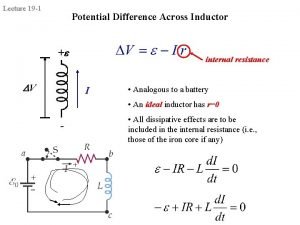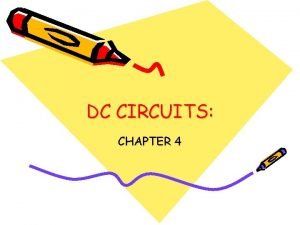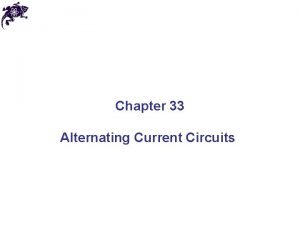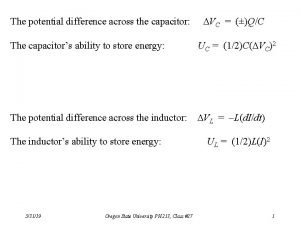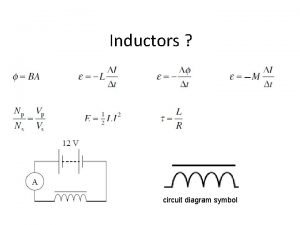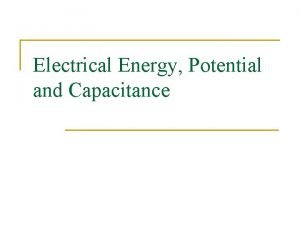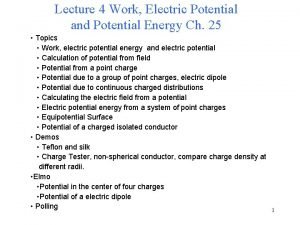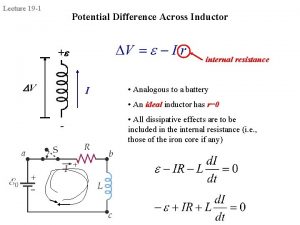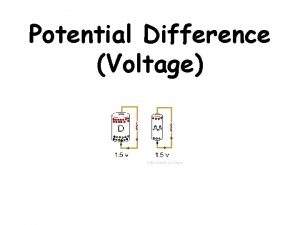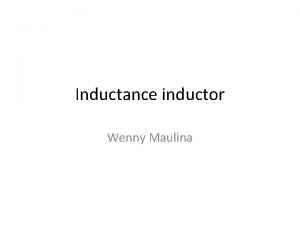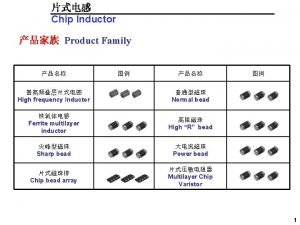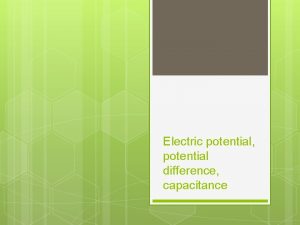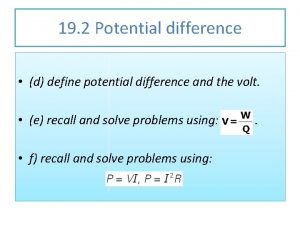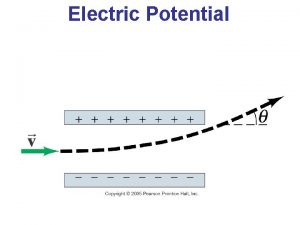Lecture 19 1 Potential Difference Across Inductor V
















- Slides: 16

Lecture 19 -1 Potential Difference Across Inductor + V internal resistance I • Analogous to a battery • An ideal inductor has r=0 - • All dissipative effects are to be included in the internal resistance (i. e. , those of the iron core if any)

Lecture 19 -2 Ways to Change Magnetic Flux • Changing the magnitude of the field within a conducting loop (or coil). • Changing the area of the loop (or coil) that lies within the magnetic field. • Changing the relative orientation of the field and the loop. motor generator http: //www. wvic. com/how-gen-works. htm

Lecture 19 -3 Alternating Current (AC) = Electric current that changes direction periodically ac generator is a device which creates an ac emf/current. A sinusoidally oscillating EMF is induced in a loop of wire that rotates in a uniform magnetic field. where ac motor = ac generator run in reverse http: //www. wvic. com/how-gen-works. htm http: //www. pbs. org/wgbh/amex/edison/sfeature/acdc. html

Lecture 19 -4 Resistive Load Start by considering simple circuits with one element (R, C, or L) in addition to the driving emf. Pick a resistor R first. + -- I(t) Kirchhoff’s Loop Rule: Ipeak v. R(t) and I(t) in phase

Lecture 19 -5 City lights viewed in a motion blurred exposure. The AC blinking causes the lines to be dotted rather than continuous (quote from Wikipedia)

Lecture 19 -6 Power Dissipated by Resistive Load VR and I in phase Power:

Lecture 19 -7 Average Power but

Lecture 19 -8 Similarly, Root-Mean-Square Values

Lecture 19 -9 Non-scored Test Quiz Which of the following statement is true? A. B. C. D.

Lecture 19 -10 Loop Rule: Capacitive Load + -- I(t) leads v(t) by 90 (1/4 cycle) Power:

Lecture 19 -11 Inductive Load Kirchhoff’s Loop Rule: v. L(t) leads I(t) by 90 (1/4 cycle) Power: + --

Lecture 19 -12 Capacitive vs Inductive Load I(t) leads v(t) by 90 capacitive reactance -- + v. L(t) leads I(t) by 90 inductive reactance + --

Lecture 19 -13 (Ideal) LC Circuit • From Kirchhoff’s Loop Rule • From Energy Conservation same harmonic oscillator with angular frequency Natural Frequency

Lecture 19 -14 LC Oscillations No Resistance = No dissipation

Lecture 19 -15 Physics 241 –Quiz 16 b – March 20, 2008 In most of Europe, the peak voltage of household outlets is 311 V. What is the rms voltage? a) 110 V b) 141 V c) 156 V d) 220 V e) 311 V

Lecture 19 -16 Physics 241 –Quiz 16 c – March 20, 2008 In Japan, the rms voltage of household outlets is 100 V. What is the peak voltage? a) 200 V b) 141 V c) 100 V d) 50 V e) 71 V
 Potential difference across inductor
Potential difference across inductor Capacitors in dc circuits
Capacitors in dc circuits Voltage across inductor
Voltage across inductor Potential difference across a capacitor
Potential difference across a capacitor Diagram of an inductor
Diagram of an inductor Equipotential lines
Equipotential lines Electric potential energy and potential difference
Electric potential energy and potential difference Sales potential vs market potential
Sales potential vs market potential Electric potential and potential difference
Electric potential and potential difference Potential energy of a system of charges
Potential energy of a system of charges Electrostatic potential
Electrostatic potential Difference between potential difference and emf
Difference between potential difference and emf 01:640:244 lecture notes - lecture 15: plat, idah, farad
01:640:244 lecture notes - lecture 15: plat, idah, farad Electric potential lecture
Electric potential lecture Physics 102
Physics 102 How to find pressure potential
How to find pressure potential Flaccid turgid and plasmolysis
Flaccid turgid and plasmolysis
